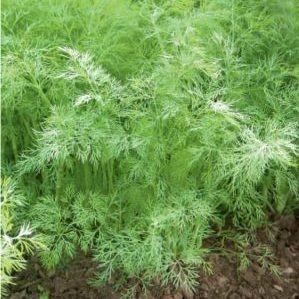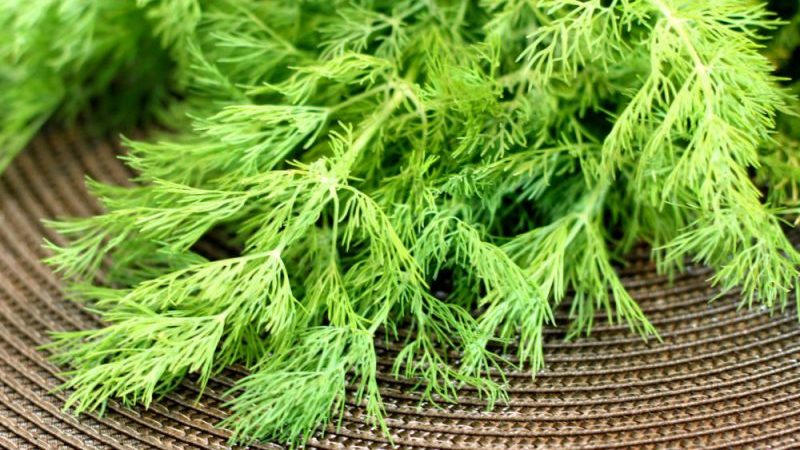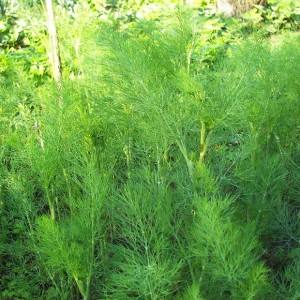The best varieties of dill for greens without umbrellas for growing in greenhouses, open ground and at home
Delicate, aromatic dill greens are ideal for salads and soups, and look attractive on a plate as a decoration for a dish. But after the appearance of umbrellas on the bushes, the greens become tough and quickly turn yellow. Such dill is not suitable for food and is only suitable for canning.
The solution for those who need only greens without umbrellas - special varieties with appropriate properties. From the article you will learn what a varietal dill for greens is and which crops are suitable for growing in open ground and greenhouses.
The content of the article
Varietal features of dill without umbrellas
The dill umbrella is the inflorescence of a plant, the place where its seeds form. There is no dill without umbrellas - such a culture would not be able to multiply. But there are varieties specially created by breeders for greenery.
Such plants remain juicy and green almost all summer and only closer to autumn they release their umbrellas with seeds so that they can start all over again next year. For convenience, we call varieties of dill with late flowering - dill without umbrellas.
The best varieties of dill without umbrellas
You have decided to grow dill without umbrellas on your site, try planting several different varieties at once. This way you will choose a culture that suits you in all respects.
They are divided into early-maturing, mid-maturing and late-maturing.
Early ripe
These plants are sown in early spring or before winter. Such varieties ripen earlier, that is, the process of flowering and shooting with umbrellas, they also begin early. But it will be possible to taste the first fragrant greens in a month.
Early maturing varieties include:
- Umbrella... Grows better in high humidity conditions. For a high and stable yield, it is advised to feed with nitrogen.

- Redoubt... Leader in yield among early maturing varieties. You can collect 50 g of greens from each bush.
- Gourmet... Differs in late stem formation. Cold resistant. It is recommended to grow in cold climates. Retains all qualities when frozen.
- Grenadier. Strong, persistent aroma. Grows back quickly after cutting.
- Gribovsky. Disease resistant, can be sown several times per season. Suitable for both open and closed ground.
Mid-season
They ripen two weeks later than the early ones, but they manage to grow much more green mass, therefore they give a high yield. They are considered the most "hot commodity" among gardeners. Umbrellas are formed at 40-45 days.
Of the mid-season varieties, the following are especially distinguished:
- Amazon. The most productive of all mid-season varieties. Up to 1.4-4.1 kg of greens per square meter are cut from one bush. m.

- Fluff. A new variety of dill with late shooting. High yield, increased resistance to fungal diseases and powdery mildew.
- Richelieu. Can be sown from April to mid-August. Reliably resists diseases and pests.
- Kibray... Forms umbrellas late. Immune to powdery mildew.
Important! To prolong the growth of the green mass of dill, it is advised to remove the first inflorescences. Then the greens can be cut off many times.
Late ripening
The period for collecting greens of late-ripening varieties of dill without umbrellas is the longest and most abundant. They are best suited for winter harvesting. Grow well in any soil.
The first cut of greens occurs 55-60 days after seedlings... These varieties do not have time to form umbrellas in the cold regions of our country.
The best late-ripening varieties:
- Salute. Not turns yellow... One bush gives up to 95 g of greens. During the season, cut off completely 3-4 times.
- Buyan. The bush is voluminous in size. For 1 sq. m there are 30 bushes. Greens from one bush can weigh up to 230 g. Demanding for watering. Good and long shelf life.
- Bushy. Suitable for open ground, unpretentious in care, greens remain juicy and soft for a long time.
- Mischievous. High grade, reaches 130 cm. High yield percentage.
- Alligator. It gives up to 70 g of greens from a bush, does not go into the arrow for a long time. Slightly susceptible to disease.
What varieties of umbrellaless dill to choose
To understand what varieties of dill you need, think about where your greens will grow? There are three possible options: open ground, a greenhouse, or at home in a pot on windowsill.
For greenhouse
For indoor conditions, mainly those varieties are chosen that do well in low light, but at the same time are distinguished by rapid growth and high yields.

These include:
- Frost. Tall variety, greenery reaches 170 cm in height. Umbrellas form late, so you can cut them all summer. One bush leaves 35-40 g of the crop. It has large foliage and a persistent, spicy aroma.
- Umbrella. Mid-season variety with giant growth. Only suitable for tall greenhouses as the stem can grow up to 2.5 m in height. Ripe greens are harvested one and a half months after planting and continue as they grow. The yield is up to 25 g per bush. The variety is appreciated for its pronounced aroma and good yield.
- Kibray. An early ripening variety, the crop can be harvested within 25 days after planting. The leaves of Kibray are juicy with a delicate taste, it has a spreading, powerful rosette, it cannot be limited in space. For best results, plant this variety at a distance of 20 cm from each other. Possesses increased resistance to diseases.
- Dill. Dutch variety with late stems. The plant is tall. Provides increased yield. The first greens are cut 28 days after germination.
- Boreas. The variety is late ripening. High yielding. It differs in that the leaves do not turn yellow and do not fade for a long time. Like many greenhouse varieties, it has a high stem up to 1.5 m.
- Ducat. Late ripe. Slow stem growth allows for a stable, high yield. After 35 days after germination, leaves and twigs can be collected - they are cut off several times during the season.
For open ground
If you plant several varieties of dill with different ripening periods on the beds, then provide yourself with greens from mid-spring to late autumn.
The best varieties of dill without umbrellas for open ground are:
- Lesnogorodsky. A mid-season variety, even after the formation of an umbrella, its leaves do not turn yellow. Plant up to 1.3 m high. Suitable for repeated cuts, unpretentious to the soil.
- Max. If meter stems of dill are not to your taste, choose Max. This is a miniature bush no more than 18 cm high, with small diamond-shaped leaves. You can get 45-55 g of spicy herbs from each.
- Kutuzovsky. A large, lush plant with rounded leaves. Has a tart aroma and excellent taste. High yielding.
- Further. Ripens in 45 days and grows up to 35 cm in height. A distinctive feature is increased resistance to pests and major diseases.
For windowsill and balcony
For those who do not own a plot of land, but really want to grow their own greenery, the following varieties are suitable that can yield crops on a windowsill or balcony:
- Gribovsky. Disease resistant, can be sown several times per season. Perfectly adapted to indoor conditions, but needs fertile soil with a sufficient supply of nutrients.
- Grenadier. Grows remarkably on windowsills, gives fragrant greens. It is this variety of dill without umbrellas that housewives most often sow in pots on balconies.To obtain a high yield, abundant watering is required 2-3 times a week.
Features of planting and growing
Dill is known for its unpretentiousness, for many gardeners this plant appears in self-sown plots, the seeds do not require maintenance, but the yield is small. To increase yields, it is recommended feed plants with complex fertilizer with a high nitrogen content.
There are a few more features, considering which, you can get several times more fresh herbs than usual:
- Prepare the seeds for planting. To do this, put them in damp gauze and leave in a warm place for two days.

- They are planted in open ground in April, in warm ground. In cold regions, it is better to postpone sowing to early May. IN greenhouse can be sown at any time at a temperature not lower than + 10 ° С.
- The grooves are made at a distance of 25 cm from each other, the seeds must be watered with warm water and only then sprinkled with earth.
- Water every 2-3 days, then loosen the ground with a hoe and remove the weeds.
- When the dill stem reaches 5-7 cm, thinning is done so that about 10 cm remains between the plants.
- Ripe greens are cut carefully, being careful not to damage the plant. In the fall, the bushes are removed along with the roots. Greens are dried or frozen.
Attention! After cutting the greens for its further growth, it is advised to water and feed the bushes with nitrogen-containing fertilizer.
Like many plants, dill is susceptible to several diseases.
The most common ones are:
- Fomoz. A fungal disease in which dark spots and black dots appear on the damaged areas, over time all the bushes fade. It is recommended to immediately get rid of infected greens, large areas are treated with 1% Bordeaux liquid and the procedure is repeated after two weeks. As a preventive measure, it is advised to avoid overcrowding of bushes and waterlogging of the soil.
- Cercosporosis. The fungus is the precursor of phomosis; oblong dark brown spots appear on the plant. It is impossible to cure the disease; greens infected with cercospora are dug up and burned.
- Peronosporosis. The disease covers the tops of the bushes at high humidity and temperatures of about + 20 ° C. To combat the disease, crushed chalk or wood ash is used, the earth and plants are sprinkled thickly.
Conclusion
Now, knowing the various varieties of dill without umbrellas, you can easily choose the ones that are right for you, and all summer you can enjoy the juicy, spicy greens of this wonderful plant.
Have a nice harvest!